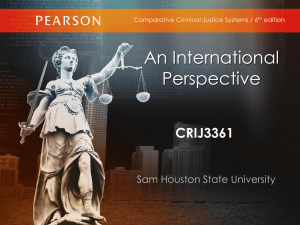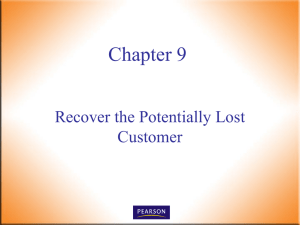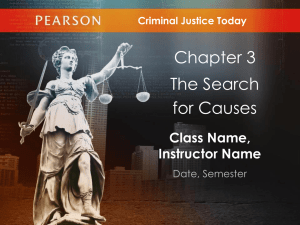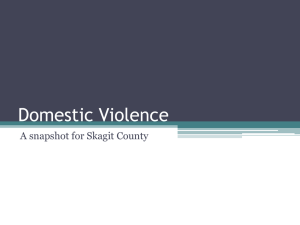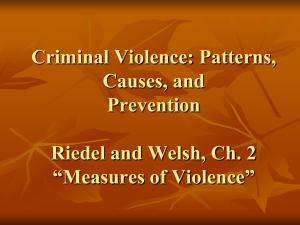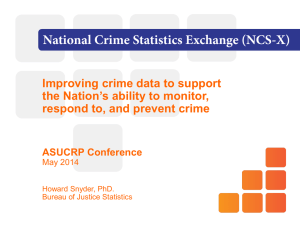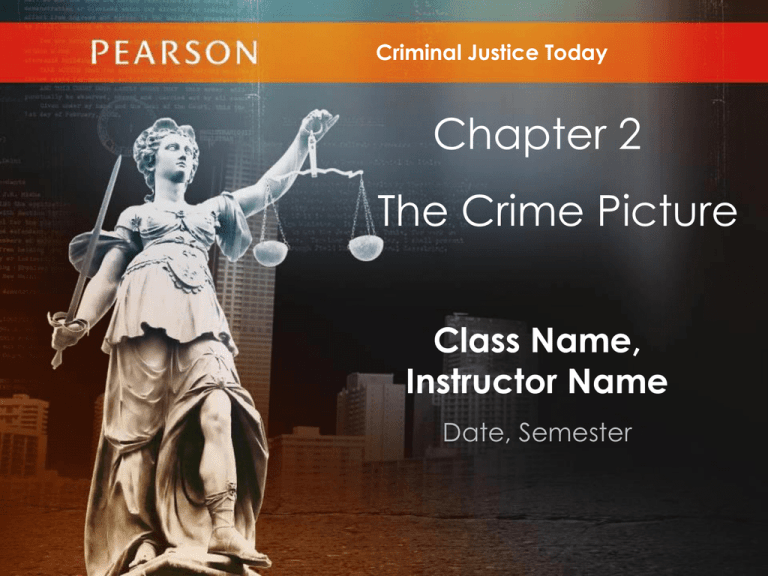
Criminal Justice Today
Chapter 2
The Crime Picture
Class Name,
Instructor Name
Date, Semester
CHAPTER AGENDA
2.1
Describe the FBI’s UCR/NIBRS Program, including its
purpose, history, and what it tells us about crime
in the United States today.
2.2
Describe the National Crime Victimization Survey
(NCVS) program, including its purpose, history,
and what it tells us about crime in the United States
today.
2.3
Compare and contrast the UCR and NCVS data
collection and reporting programs.
2.4
Describe how the special categories of crime
discussed in this chapter are significant today.
© 2013 by Pearson Higher Education, Inc
Upper Saddle River, New Jersey 07458 • All Rights Reserved
2.0
Key Terms: Offenses
3
Murder
Rape
Robbery
Aggravated
Assault
Burglary
Larceny
Motor
Vehicle Theft
Arson
© 2013 by Pearson Higher Education, Inc
Upper Saddle River, New Jersey 07458 • All Rights Reserved
Learning Objectives
After this lecture you should be able to complete the following Learning Outcomes
2.1
Describe the FBI’s UCR/NIBRS
Program, including its purpose,
history, and what it tells us about
crime in the United States today.
© 2013 by Pearson Higher Education, Inc
Upper Saddle River, New Jersey 07458 • All Rights Reserved
2.1
Also Known Today as the
UCR/NIBRS Program
Produces an Annual Overview
of Major Crime Titled Crime in
the United States
© 2013 by Pearson Higher Education, Inc
Upper Saddle River, New Jersey 07458 • All Rights Reserved
2.1
FBI’s UCR Program Initiated
Development of a New
National Crime Collection
Represents a Significant
Redesign of the Original
UCR Program
The Original UCR System Was
“Summary Based,” the Newly
Enhanced NIBRS Is Incident
Driven
City, County, State, and
Federal Law Enforcement
Agencies Furnish Detailed
Data on Crime and Arrest
Activities at the Incident Level
© 2013 by Pearson Higher Education, Inc
Upper Saddle River, New Jersey 07458 • All Rights Reserved
2.1
Against
Persons
Against
Property
Against
Public Order
© 2013 by Pearson Higher Education, Inc
Upper Saddle River, New Jersey 07458 • All Rights Reserved
2.1
Criminal
Homicide
Rape
Assault
Robbery
Burglary
Larceny
Against
Persons
Against
Property
Motor Vehicle
Theft
Against
Public Order
© 2013 by Pearson Higher Education, Inc
Upper Saddle River, New Jersey 07458 • All Rights Reserved
Arson
2.1
Traditional
UCR
9
Enhanced
UCR/NIBRS
© 2013 by Pearson Higher Education, Inc
Upper Saddle River, New Jersey 07458 • All Rights Reserved
2.1
2010 Crime Clock – Violent Crimes
One Murder every --- 34.5 minutes
One Forcible Rape every --- 6.0 minutes
One Robbery every --- 1.3 minutes
One Aggravated Assault every --- 39.1 seconds
© 2013 by Pearson Higher Education, Inc
Upper Saddle River, New Jersey 07458 • All Rights Reserved
2.1
20 Crime Clock – Property Crimes
One Burglary every --- 14.3 seconds
One Larceny-theft every --- 5.0 seconds
One Motor Vehicle Theft every --- 39.7 seconds
© 2013 by Pearson Higher Education, Inc
Upper Saddle River, New Jersey 07458 • All Rights Reserved
2.1
Major Crimes Known to the Police, 2010
Offense
Number Rate per 100,000
Clearance Rate
Personal/Violent Crimes
Murder
16,272
5.4
63.6
Forcible Rape
89,000
29.3
40.4
Robbery
441,855
145.3
26.8
Aggravated Assault
834,885
274.6
54.9
Burglary
2,222,196
730.8
12.5
Larceny-Theft
6,588,873
2167.0
19.9
956,846
314.7
12.0
56,972
24.1
18.0
11,206,899
3,685.0
Property Crimes
Motor Vehicle Theft
Arson1
U.S. Total
1Arson
can be classified as either a property crime or a violent crime depending on whether personal injury or loss of life results from it’s
commission. It is generally classified as a property crime, however. Arson statistics are incomplete for 2010.
Source: Adapted from Federal Bureau of Investigation, Crime in the United States, 2010 (Washington DC: U.S. Department of Justice, 2011).
12
© 2013 by Pearson Higher Education, Inc
Upper Saddle River, New Jersey 07458 • All Rights Reserved
2.1
UCR/NIBRS Part II Offenses, 2010
Part II Offenses
Offense Category
Number
Simple Assaults
1,298,342
Forgery and Counterfeiting
90,127
Fraud
234,199
Embezzlement
21,402
Stolen Property (e.g., Receiving)
111,319
Vandalism
285,012
Weapons (e.g., Carrying)
179,661
Prostitution and Related Offenses
75,004
Sex Offenses (e.g., Statutory Rape)
79,914
Drug-Law Violations
1,702,537
Gambling
9,811
Offenses Against the Family (e.g., Nonsupport)
118,419
Driving Under the Influence
1,483,396
Liquor-Law Violations
625,939
Public Drunkenness
611,069
Disorderly Conduct
685,985
Vagrancy
33,852
Curfew Violations/Loitering
133,063
Runaways
109,225
Source: Adapted from Federal Bureau of Investigation, Crime in the United States, 20010(Washington DC: U.S. Department of Justice, 2011).
13
© 2013 by Pearson Higher Education, Inc
Upper Saddle River, New Jersey 07458 • All Rights Reserved
Learning Objectives
After this lecture you should be able to complete the following Learning Outcomes
2.2
Describe the National Crime
Victimization Survey (NCVS) program,
including its purpose, history, and
what it tells us about crime in the
United States today.
© 2013 by Pearson Higher Education, Inc
Upper Saddle River, New Jersey 07458 • All Rights Reserved
2.2
© 2013 by Pearson Higher Education, Inc
Upper Saddle River, New Jersey 07458 • All Rights Reserved
2.2
NCVS
Statistics
for Recent
Years
Reveal the
Following:
of American Households
Are Touched by Crime Every Year
16
© 2013 by Pearson Higher Education, Inc
Upper Saddle River, New Jersey 07458 • All Rights Reserved
2.2
NCVS
Statistics
for Recent
Years
Reveal the
Following:
Victimizations per Year
17
© 2013 by Pearson Higher Education, Inc
Upper Saddle River, New Jersey 07458 • All Rights Reserved
2.2
NCVS
Statistics
for Recent
Years
Reveal the
Following:
City Residents Are Almost
as Rural Residents to Be Victims of Crime
18
© 2013 by Pearson Higher Education, Inc
Upper Saddle River, New Jersey 07458 • All Rights Reserved
2.2
NCVS
Statistics
for Recent
Years
Reveal the
Following:
19
© 2013 by Pearson Higher Education, Inc
Upper Saddle River, New Jersey 07458 • All Rights Reserved
2.2
NCVS
Statistics
for Recent
Years
Reveal the
Following:
Victims of Crime Are
Than Women
20
© 2013 by Pearson Higher Education, Inc
Upper Saddle River, New Jersey 07458 • All Rights Reserved
2.2
NCVS
Statistics
for Recent
Years
Reveal the
Following:
Than the Elderly to Be
21
© 2013 by Pearson Higher Education, Inc
Upper Saddle River, New Jersey 07458 • All Rights Reserved
2.2
NCVS
Statistics
for Recent
Years
Reveal the
Following:
Than Whites or Members of Other Racial
Groups to Be
22
© 2013 by Pearson Higher Education, Inc
Upper Saddle River, New Jersey 07458 • All Rights Reserved
2.2
NCVS
Statistics
for Recent
Years
Reveal the
Following:
23
© 2013 by Pearson Higher Education, Inc
Upper Saddle River, New Jersey 07458 • All Rights Reserved
Comparison of UCR/NIBRS and NCVS
Data, 2010
2.2
Offense
UCR/NIBRS
NCVS1
Homicide
16,272
—
Forcible Rape2
89,000
203,830
Robbery
441,855
551,830
Aggravated Assault
834,885
839,940
Burglary3
2,222,196
3,188,620
Larceny
6,588,873
12,335,400
956,846
795,160
56,972
—
11,206,899
21,312,4005
Personal/Violent Crimes
Property Crimes
Motor Vehicle Theft
Arson4
Total of All Crimes Recorded
1NCVS
data cover “Households touched by crime,” not absolute numbers of crime occurrences. More than one victimization may occur per household, but only the
number of households in which victimizations occur enters the tabulations.
2NCVS
statistics include both rape and sexual assault.
3NCVS
statistics include only household burglary and attempts.
4Arson
data are incomplete in the UCR/NIBRS and are not reported by the NCVS.
5IIncludes
NCVS crimes not shown in the table, including 3.3 million simple assaults.
Source: Compiled from U.S. Department of Justice, Criminal Victimization, 2010 (Washington, DC: Bureau of Justice Statistics, 2011);
and Federal Bureau of Investigation, Crime in the United States, 2010 (Washington , DC: U.S. Department of Justice, 2011).
24
© 2013 by Pearson Higher Education, Inc
Upper Saddle River, New Jersey 07458 • All Rights Reserved
Learning Objectives
After this lecture you should be able to complete the following Learning Outcomes
2.3
Compare and contrast the UCR and
NCVS data collection and reporting
programs.
© 2013 by Pearson Higher Education, Inc
Upper Saddle River, New Jersey 07458 • All Rights Reserved
2.3
UCR/NIBRS
The Belief That the Police
Can't Do Anything
Fear of Reprisal
Embarrassment About the
Crime Itself/or Fear During
26
NCVS
False or Exaggerated Reports
Unintentional Inaccuracies
•
Memory Problems/May Not
Remember the Exact Details
Forgotten Crimes
© 2013 by Pearson Higher Education, Inc
Upper Saddle River, New Jersey 07458 • All Rights Reserved
Learning Objectives
After this lecture you should be able to complete the following Learning Outcomes
2.4
Describe how the special categories
of crime discussed in this chapter are
significant today.
© 2013 by Pearson Higher Education, Inc
Upper Saddle River, New Jersey 07458 • All Rights Reserved
2.4
Special Categories of Crime
Crimes
against
Women
Crimes
against
the Elderly
Hate
Crimes
White-Collar
Crimes
Organized
Crime
Gun
Crime
Drug
Crime
Cybercrime
Terrorism
© 2013 by Pearson Higher Education, Inc
Upper Saddle River, New Jersey 07458 • All Rights Reserved
CHAPTER SUMMARY
2.1
Describe the FBI’s UCR/NIBRS Program, including its
purpose, history, and what it tells us about crime
in the United States today.
2.2
Describe the National Crime Victimization Survey
(NCVS) program, including its purpose, history,
and what it tells us about crime in the United States
today.
2.3
Compare and contrast the UCR and NCVS data
collection and reporting programs.
2.4
Describe how the special categories of crime
discussed in this chapter are significant today.
© 2013 by Pearson Higher Education, Inc
Upper Saddle River, New Jersey 07458 • All Rights Reserved

